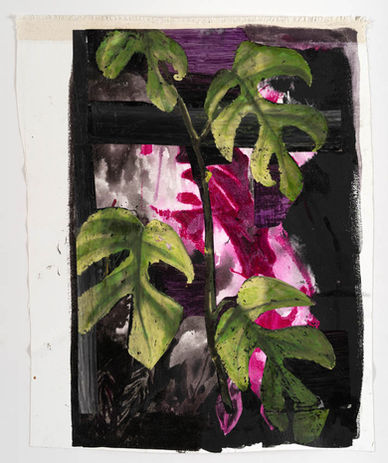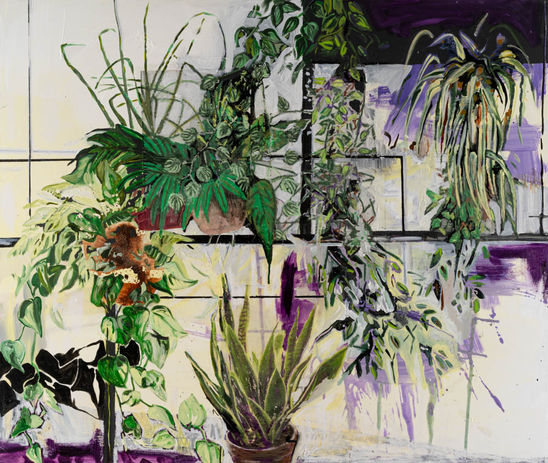Homebound
Artist:
28.2.22
Main Gallery
Curator: Tal Amitai-Lavi
Click image to view Catalog
צמוד קרקע, עץ, עציץ
על תערוכתה של מיכל גבע אֶל–ביתי, גלריה מאיה, תל אביב
אוצרת: טל אמיתי־לביא
נופים נטורליסטיים פרומים דמויי־חלום, שיופיים טבעי ומעורער, מאפיינים את סדרת עבודותיה החדשה של מיכל גבע. ממוקדת בטבע ובארכיטקטורה – בית ילדותה בתל אביב – היא חורגת מן המקרה האישי־ביוגרפי למחוזות אוניברסליים יותר ונוגעת באופן מרומז בסוגיות של זהות, מקום, שייכות והגירה.
במבט ראשון, אנו עשויים ללכת שולל ולראות בעבודות ייצוג גנרי של תמונות נוף פסטורליות סכריניות, התגלמות חלומה של כל משפחה בורגנית – בית צמוד קרקע עם גג רעפים, גינה וגדר. אולם מבעד ליופיו וצבעוניותו הטרופית המפתה, הציור אפוף תחושה מורבידית המעוררת מתח וחרדה. הבית, על הפורמליזם האדריכלי שלו, פוגש בצורותיו האורגניות־אמורפיות של הטבע – פראי, סבוך ובלתי ניתן למשטור. עצים וצמחים פולשים אל תוך הבית, מאיימים לאיין אותו ואילו הוא מצידו מבקש להקיאם מקרבו, או אולי במהלך הפוך, לבולעם. זוהי תנועה דו־כיוונית: הפנים (הבית), חודר אל החוץ (הטבע) ולהיפך, במעין מחול שדים סימביוטי שתוצאותיו הרות גורל.
מיכל גבע היא ציירת היודעת את מלאכתה היטב. הפרקטיקות הציוריות שלה אינן טכניות גרידא והולמות את תוכן עבודתה. כבתו של צייר ונכדתו של בנאי־אדריכל, מורשתה היא מורשת של אדריכלים וציירים. המרחב הציורי שלה הוא זירה של תהליכים מנוגדים המתרחשים בו־זמנית כמו בנייה ופירוק, חשיפה והסתרה, השטחה וריבוד. אפשר לדמות את פעולת הציור למלאכת בנייה: בפעולה עמלנית וחזרתית, רושם המכחול קיר עשוי לבני סיליקט אדומות, קובע חלונות ודלתות במעין גריד המבקש למפות את העולם ולברוא מציאות עמידה הניתנת לתפיסה ולפענוח. ואולם, בה בעת, נדמית פעולת הבנייה המתבצעת על קרקע שאינה יציבה כמעשה הרס מכוון. מתחת למצע הציור ולתמונות הנוף הפסטורליות, כחלק בלתי נפרד מתבנית הנוף, הבית ומפת הנפש, חבוי פוטנציאל ההתפרקות והקריסה.
כציירים רבים אחרים, משתמשת גבע בתצלומים כרפרנס, ואף משלבת את התצלום הפיזי ואת חלקיו השסועים – קרעי קולאז' בצבע ובשחור לבן – בציוריה המרובדים פורמלית ורעיונית. הציורים בנויים מצורות שבורות, עיוותים פרספקטיביים, שיבושים אדריכליים ושימוש בשפות סגנוניות שונות. בתהליך העבודה על הציור טומנת גבע מכשולים ומבצעת פעולות שעלולות להביא לכישלונו. פעולות אקראיות שהיא יוזמת בסטודיו מעבירות את השליטה מידיה אל החומר, אל המצע הציורי, אל המפגש הקונפליקטואלי בין דימויים לאלמנטים ציוריים. התנגשויות, התפוצצויות, שברים ונזילות נראים תדיר במרחב הציורי שלה. לצידם, מחיקה, טשטוש, עיוות, שוליים של חוסר צורה, מלווים את הצורה שזה עתה נוצרה.
בספרו הבית והדרך כותב איתמר לוי: "המסע והבית כרוכים זה בזה; הבית הוא המקום שאליו אנו כמהים, אך הוא גם המקום המאיים, הבולע, המקום שאליו אי אפשר להגיע, אך לעולם גם לא ניתן לעוזבו לחלוטין". הביוגרפיה של מיכל גבע, הנעה תדיר בין מרחבים גיאוגרפים ומנטליים שונים – קיבוץ עין שמר; ניו יורק; תל אביב; ניו יורק; פרדס חנה – ממחישה את כמיהתה האינסופית לבית, לחוף מבטחים ולשייכות, המוצבים בסימן שאלה וספק תמידי. סדרת הציורים הנוכחית חושפת כמיהה זו, בעודה חותרת תחת הנראות של היציב והמקובע.
"תל אביב היא המקום בו כל חושיי חוזרים למקומם", כתבה מיכל גבע בעת שהתגוררה בברוקלין, "היא כה מוכרת, מוכרת מדי. אינטימית מדי. מאחורי כל קרן רחוב טמונה הפתעה שיכולתי לצפות מראש. שום דבר לא הגיוני ובה בעת הכול מובן. היא כל כך יפה. מכוערת. אני חולמת אודותיה: יכולה לשמוע את שאון הלילה. אני רוצה להיות שם ואני רוצה לברוח משם. יש קונפליקט מתמשך, הוא הבית".
טל אמיתי־לביא, ינואר 2022
Michal Geva's new series of works unravels dream-like landscapes of natural and unsettling beauty. Focusing on nature and architecture – her childhood home in Tel Aviv – she transcends the personal-biographical circumstances to more universal realms, touching on questions of identity, place, belonging, and immigration.
At first glance, one might see the works as mere generic representations of saccharine pastoral landscapes, the quintessential middle-class dream – white picket fence, red tiled roof, and a front yard. However, through its seductive beauty and tropical bold colors, the painting evokes a morbid feeling, triggering tension and anxiety. With its architectural formalism, the house meets the organic-amorphous forms of nature — wild, tangled, and uncontainable. Trees and plants invade the house, threatening to overcome it, while the house in turn wishes to expel them from its bowels, or alternatively, to swallow them. This is a two-way movement: the interior (the house), penetrates the outside (nature) and vice versa, in a symbiotic frenzied tango that carries fateful consequences.
Michal Geva is a skillful and knowledgeable artist whose painting practices are not merely technical but rather complement the subject matters of her work. As the daughter of a painter and the granddaughter of a builder-architect, her legacy is one of architects and painters. The space of her paintings is an arena of simultaneous opposing processes – construction and disassembly, exposure and concealment, flattening and layering. The act of painting can be likened to the craft of building: in a labor-intensive repetitive action, the brush draws a wall of red silicate bricks, sets windows and doors in a grid that wishes to chart the world and create a stable reality, one that can be perceived and deciphered. At the same time, however, the construction carried out on unstable ground seems like an intentional act of destruction. Beneath the surface of the painting and the pastoral picture lurk potential disintegration and collapse as intrinsic facets of landscape, home, and the map of the psyche.
Like many other painters, Geva uses photographs as references, and even incorporates the physical photo and its torn pieces – color or black and white collage fragments – in her formally and conceptually layered paintings. The paintings are composed of broken shapes, perspective deformations, architectural distortions, and various stylistic languages. In her work process, she lays out pitfalls and performs actions that may bring about the painting’s failure. Random actions set in motion in the studio shift control from her to the material, to the painting’s support, to the conflictual encounter between imagery and painting elements. Collisions, explosions, fractures, and drips often fill her pictorial space, alongside erasure, blurring, distortion, and amorphous edges that surround the newly-formed shape.
In his book, Home and Road, Itamar Levy writes: “The journey and the home are intertwined; home is the place we long for, but it is also the menacing, consuming place, the place you can never reach but also never fully leave.” The biography of Michal Geva, who constantly moves between various geographic and mental places – Kibbutz Ein Shemer; New York; Tel Aviv; New York; Pardes Hanna – demonstrates her endless longing for a home, for a haven and belonging that are constantly put into question and doubt. The current series of paintings exposes this longing, while undermining the appearance of what seems stable and fixed.
“Tel Aviv is the place where all my senses regain their place,” Michal Geva wrote while she lived in Brooklyn. “It’s so familiar, too familiar. Too intimate. Behind every corner lies a surprise I could have predicted. Nothing makes sense and at the same time everything is understandable. It is so beautiful. It is ugly. I dream of it: I can hear the sound of the night. I want to be there and I want to escape it. There is an ongoing conflict, that is home.”
Tal Amiti-Lavi, January 2022











